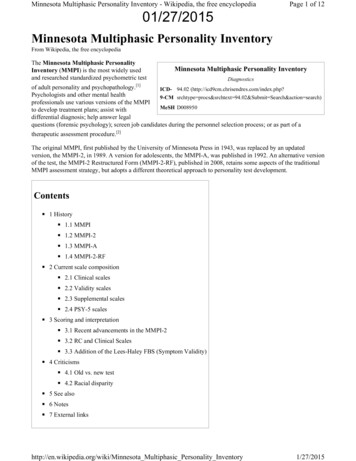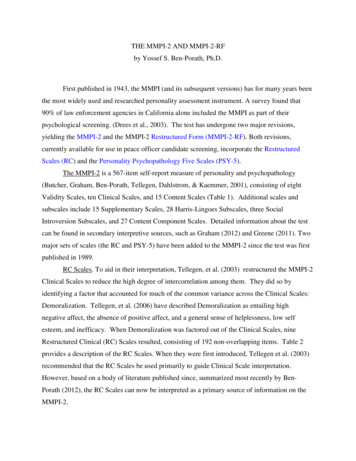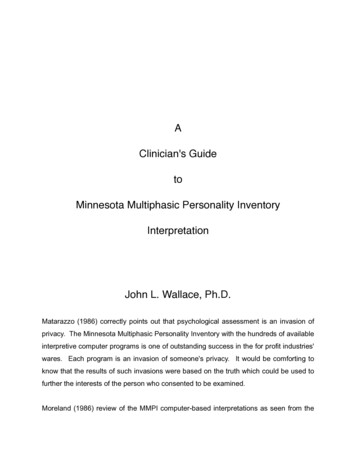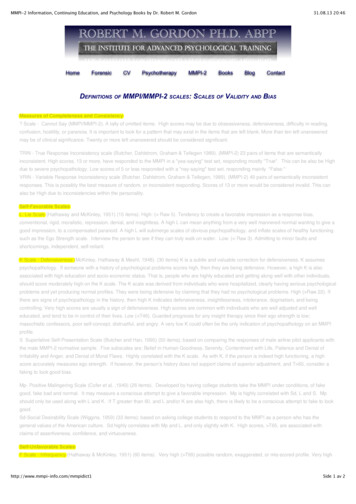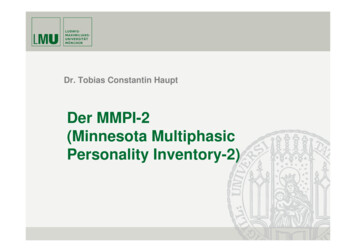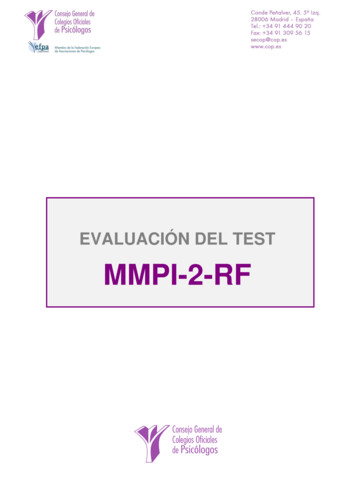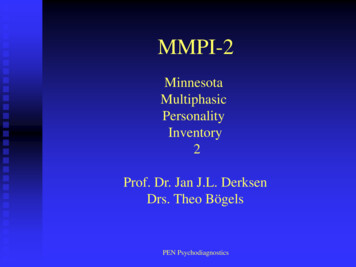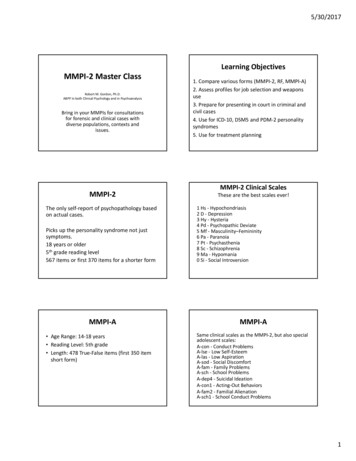
Transcription
SAMPLE REPORTCase Description: Tyler — SchoolInterpretive ReportTyler is a 15-year-old white ninth-grade student who was referred to the school psychologist because ofdisruptive behaviors, including fighting and verbal outbursts. He got into a dispute with another student andshoved him against a locker. This behavior was observed by the teacher who was serving as hall monitor.Tyler was placed on a three-day suspension. A week after he returned to school, he and two classmateswere suspected of bringing alcohol onto school grounds (as reported by one of their classmates), althoughthis charge was not verified. At that point the assistant principal referred him to the school psychologist.Although Tyler was distant, argumentative, and uncooperative during his initial interview with thepsychologist, he agreed to complete an MMPI-A at the end of the session. Despite his attitude duringthe interview, Tyler’s MMPI-A Validity Scales profile indicated that he was open and cooperative in hisresponses to the MMPI-A items. His Minnesota Report confirms a pattern of multiple and serious behaviorproblems that was also readily apparent to school personnel. His elevated MAC-R score suggests a referral/evaluation of his alcohol and drug use behaviors may be appropriate. His elevation on ACK, (Alcohol/Drug Problem Acknowledgement Scale), as well as his item-level indicators in the Substance Use/Abusecategory, indicated that he was willing to acknowledge problematic use, at least through MMPI-A content.While his conduct problems are prominent in his profiles, there are indicators of excessive worrying, selfcriticism, and a potential for suicidal thoughts and/or behaviors that also require further assessment, alsohighlighted in the Minnesota Report.Tyler’s PSY-5 profile, with the elevation on Negative Emotionality/Neuroticism Scale, combined withhis moderate elevation on the A-CYN Content Scale (mostly due to the items on the InterpersonalSuspiciousness Content Component Scale) indicates problems in interpersonal relationships. He is likelyvery distrustful of others, and expects the worst. This will interfere with establishing a therapeuticrelationship. On the other hand, he likely makes a good first impression and did endorse content suggestinga desire to succeed in life.Case descriptions do not accompany MMPI-A reports, but are provided here as background information. The followingreport was generated from Q-global , Pearson’s web-based scoring and reporting application, using Tyler’s responses tothe MMPI-A. Additional MMPI-A sample reports, product offerings, training opportunities, and resources can be foundat PearsonClinical.com/mmpia.Copyright 2014 Pearson Education, Inc. or its affiliate(s). All rights reserved. Q-global, Always Learning, Pearson, design for Psi, and PsychCorp are atrademarks, in the U.S. and/or other countries, of Pearson Education, Inc. or its affiliate(s).Minnesota Multiphasic Personality Inventory-A and MMPI-A are registered trademarks of the University of Minnesota, Minneapolis, MN. 8795-A 01/14
SAMPLE REPORTCase Description (continued): Tyler — SchoolInterpretive ReportAfter reviewing the Minnesota Report test scores and narrative, the school psychologist decided to useTyler’s next evaluation session to provide feedback from the MMPI-A to see if he will be more forthcomingin describing his problems so that an appropriate plan is developed to meet both his treatment andeducational needs.
School Interpretive ReportTyler SampleCase111115Male1/27/14SAName:ID Number:Age:Gender:Date Assessed:MPLEMMPI -AThe Minnesota Report : Adolescent Interpretive System, 2nd EditionJames N. Butcher, PhD, & Carolyn L. Williams, PhDCopyright 1992, 2007 by the Regents of the University of Minnesota. All rights reserved. Portions reproduced from the MMPI-A test booklet.Copyright 1942, 1943, (renewed 1970), 1992 by the Regents of the University of Minnesota. All rights reserved. Portions excerpted from theMMPI-A Manual for Administration, Scoring, and Interpretation. Copyright 1992 by the Regents of the University of Minnesota. All rightsreserved. Portions excerpted from the Supplement to the MMPI-A Manual for Administration, Scoring, and Interpretation: The ContentComponent Scales, The Personality Psychopathology Five (PSY-5) Scales, The Critical Items. Copyright 2006 by the Regents of theUniversity of Minnesota. All rights reserved. Distributed exclusively under license from the University of Minnesota by NCS Pearson, Inc.MMPI and Minnesota Multiphasic Personality Inventory are registered trademarks and MMPI-A, Minnesota Multiphasic PersonalityInventory-Adolescent, and The Minnesota Report are trademarks of the University of Minnesota. Pearson, the PSI logo, and PsychCorpare trademarks in the U.S. and/or other countries of Pearson Education, Inc., or its affiliate(s).TRADE SECRET INFORMATIONNot for release under HIPAA or other data disclosure laws that exempt trade secrets from disclosure.[ 4.4 / 1 / QG ]
ID: 1111Tyler SampleCaseMMPI -A School Interpretive Report1/27/14, Page 2MMPI-A VALIDITY SCALES PROFILE110110100100908080E90604030TRINSAVRINT Score:Response %:Cannot Say (Raw):60F50Raw 001001001001001001002Percent True:46Percent False:54
ID: 1111Tyler SampleCaseMMPI -A School Interpretive Report1/27/14, Page 3MMPI-A CLINICAL AND SUPPLEMENTARY SCALES cMaSiRaw Score:1127202919131926262730T Score:556548704450505259517098 100 1009998 100Welsh Code:100 100100 1004'2 -918067/35: FKL/Mean Profile Elevation:56.160504030HsResponse %:70MPL70MAC-R ACKPROIMMAR7161313126349494847100 100 100 100 100 100
ID: 1111Tyler SampleCaseMMPI -A School Interpretive Report1/27/14, Page 4MMPI-A CONTENT SCALES 030A-anx A-obs A-dep A-hea A-aln A-biz A-ang A-cyn A-con A-lse A-las A-sod A-fam A-sch A-trtRaw Score:T Score:Response 2100 100 100 100 100 100 100 100 100 100 100 10097 100 100
ID: 1111Tyler SampleCaseMMPI -A School Interpretive Report1/27/14, Page 5MMPI-A PSY-5 SCALES 04030AGGRPSYC30DISCNEGEINTRRaw Score:11713143T Score:5355596041100100100100100Response %:80
ID: 1111Tyler SampleCaseMMPI -A School Interpretive Report1/27/14, Page 6VALIDITY CONSIDERATIONSThis adolescent's approach to the MMPI-A was open and cooperative. The resulting MMPI-A is validand is probably a good indication of his present level of personality functioning. This may be viewed asa positive indication of his involvement with the evaluation.SYMPTOMATIC BEHAVIOREThis adolescent's MMPI-A clinical profile indicates multiple serious behavior problems includingschool maladjustment, family discord, and authority conflicts. He can be moody, resentful, andattention-seeking. At times he may appear rebellious, impulsive, and argumentative. His poor judgmentmay get him into trouble. He can be self-centered and may show little remorse for his bad behavior. Hemay run away or lie to avoid punishment.MPLHis two highest MMPI-A clinical scales, D and Pd, which are clearly elevated above other scales, occuras a high-point pair in less than 1% of the normative sample.In a large archival sample of MMPI-A cases scored by Pearson Assessments (n 19,048), thishigh-point pair of scale elevations (Pd and D) was found for 2.9% of the boys, using well-defined peakscores of 65 or above, and more than 5 points separation from the third highest scale.SAAn examination of the adolescent's underlying personality factors with the PSY-5 scales might helpexplain any behavioral problems he might be presently experiencing. He tends to view the world in anegative manner as shown by his moderate score on the Negative Emotionality/Neuroticism scale.Adolescents with moderate scorers may develop the worst-case scenario to events affecting him. Thereis some suggestion that he tends to worry to excess and may view even neutral events as problematic.His characteristic self-critical nature may prevent him from viewing relationships in a positive manner.INTERPERSONAL RELATIONSInitially, he may seem likable and may make a good impression on others; however, his relationshipstend to be very troubled. His behavior is primarily hedonistic and self-centered, and he is quiteinsensitive to the needs of other people, exploiting them and feeling no guilt about it.The MMPI-A Content Scales profile provides some additional information about his interpersonalrelationships. He reported some misanthropic attitudes, indicating distrust of others and theirmotivations. He may be on guard when people seem friendlier than he thinks they should be.
ID: 1111Tyler SampleCaseMMPI -A School Interpretive Report1/27/14, Page 7BEHAVIORAL STABILITYThe relative scale elevation of the highest scale (Pd) in his clinical profile reflects high profiledefinition. If he is retested at a later date, the peak score on this test is likely to retain its relative saliencein his profile pattern. Adolescents with this clinical profile may have a history of acting-out behaviorsand relationship problems.DIAGNOSTIC CONSIDERATIONSMore information is needed about his behavior problems before a definitive diagnosis can be made. HisPd elevation suggests that behavior problems should be considered.MPLEHis extremely high score on the MAC-R scale suggests substantial problems with alcohol or otherdrugs. He probably engages in risk-taking behaviors and tends towards exhibitionism. Further evaluationof his alcohol or other drug use is strongly recommended.He has endorsed items that confirm his increasing involvement with alcohol or other drugs. Heacknowledges that his use is problematic and reports being criticized for it. He may feel that alcohol orother drugs facilitate social interactions, thus serving as a coping strategy.TREATMENT CONSIDERATIONSSAHis conduct disturbance should figure prominently in any treatment planning. His clinical scales profilesuggests that he is a poor candidate for traditional, insight-oriented psychotherapy. A behavioral strategyis suggested. Clearly stated contingencies that are consistently followed are important for shaping moreappropriate behaviors.His very high potential for developing alcohol or drug problems requires attention in therapy ifimportant life changes are to be made. He has acknowledged some problems in this area, which is avaluable first step for intervention.He should be evaluated for the presence of suicidal thoughts and any possible suicidal behaviors. If heis at risk, appropriate precautions should be taken.He did endorse content suggesting a desire to succeed in life. There may be some positive aspects aboutschool that could be reinforced. This could be an asset to build on during treatment.
ID: 1111Tyler SampleCaseMMPI -A School Interpretive Report1/27/14, Page 8ADDITIONAL SCALESA subscale or content component scale should be interpreted only when its corresponding parent scalehas an elevated T score of 60 or above. Subscales and content component scales printed below in boldmeet that criterion for interpretation.Raw ScoreT ScoreResp 100100100100Psychopathic Deviate SubscalesFamilial Discord (Pd1)Authority Problems (Pd2)Social Imperturbability (Pd3)Social Alienation (Pd4)Self-Alienation (Pd5)454955360546953100100100100100Paranoia SubscalesPersecutory Ideas (Pa1)Poignancy (Pa2)Naivete 10010010048345957494810010010089Depression SubscalesSubjective Depression (D1)Psychomotor Retardation (D2)Physical Malfunctioning (D3)Mental Dullness (D4)Brooding (D5)SAMPLHysteria SubscalesDenial of Social Anxiety (Hy1)Need for Affection (Hy2)Lassitude-Malaise (Hy3)Somatic Complaints (Hy4)Inhibition of Aggression (Hy5)EHarris-Lingoes SubscalesSchizophrenia SubscalesSocial Alienation (Sc1)Emotional Alienation (Sc2)Lack of Ego Mastery, Cognitive (Sc3)Lack of Ego Mastery, Conative (Sc4)Lack of Ego Mastery, Defective Inhibition (Sc5)Bizarre Sensory Experiences (Sc6)Hypomania SubscalesAmorality (Ma1)Psychomotor Acceleration (Ma2)Imperturbability (Ma3)Ego Inflation (Ma4)
ID: 1111Tyler SampleCaseMMPI -A School Interpretive Report1/27/14, Page 9Raw ScoreT ScoreResp %727534748100100100Adolescent DepressionDysphoria (A-dep1)Self-Depreciation (A-dep2)Lack of Drive (A-dep3)Suicidal Ideation (A-dep4)232055594742100100100100Adolescent Health ConcernsGastrointestinal Complaints (A-hea1)Neurological Symptoms (A-hea2)General Health Concerns (A-hea3)162595651100100100Social Introversion SubscalesShyness / Self-Consciousness (Si1)Social Avoidance (Si2)Alienation--Self and Others (Si3)MPLEContent Component Scales213504664100100100Adolescent Bizarre MentationPsychotic Symptomatology (A-biz1)Paranoid Ideation (A-biz2)114353100100Adolescent AngerExplosive Behavior (A-ang1)Irritability (A-ang2)455554100100Adolescent CynicismMisanthropic Beliefs (A-cyn1)Interpersonal Suspiciousness (A-cyn2)985465100100Adolescent Conduct ProblemsActing-Out Behaviors (A-con1)Antisocial Attitudes (A-con2)Negative Peer Group Influences (A-con3)430504641100100100Adolescent Low Self-EsteemSelf-Doubt (A-lse1)Interpersonal Submissiveness (A-lse2)104038100100Adolescent Low AspirationsLow Achievement Orientation (A-las1)Lack of Initiative (A-las2)324749100100SAAdolescent AlienationMisunderstood (A-aln1)Social Isolation (A-aln2)Interpersonal Skepticism (A-aln3)
ID: 1111Tyler SampleCaseMMPI -A School Interpretive Report1/27/14, Page 10T ScoreResp %435044100100Adolescent Family ProblemsFamilial Discord (A-fam1)Familial Alienation (A-fam2)80503995100Adolescent School ProblemsSchool Conduct Problems (A-sch1)Negative Attitudes (A-sch2)316941100100Adolescent Negative Treatment IndicatorsLow Motivation (A-trt1)Inability to Disclose (A-trt2)354959100100ERaw ScoreAdolescent Social DiscomfortIntroversion (A-sod1)Shyness (A-sod2)SAMPLUniform T scores are used for Hs, D, Hy, Pd, Pa, Pt, Sc, Ma, the content scales, the content componentscales, and the PSY-5 scales. The remaining scales and subscales use linear T scores.
MMPI -A School Interpretive Report1/27/14, Page 11ID: 1111Tyler SampleCaseITEM-LEVEL INDICATORSThe MMPI-A contains a number of items whose content may indicate the presence of psychologicalsymptoms when endorsed in the deviant direction. The MMPI-A critical item list includes 15 categoriesthat may provide an additional source of hypotheses about this young person.However, caution should be used when interpreting item-level indicators like the MMPI-A criticalitems because responses to single items are much less reliable than scores on full-length scales. Anindividual can easily mismark or misunderstand a single item, and not intend the answer given.Furthermore, many adolescents in the normative sample endorsed some of the MMPI-A critical items inthe deviant direction. For this reason, the responses to the item-level indicators printed below include theendorsement frequency for the item in the normative sample to give the clinician an indication of howcommon or rare the response is in the general population.EAnxiety(Of the six possible items in this section, one was endorsed in the scored direction):MPL163. Item Content Omitted. (23.1% of the normative boys responded True.)Conduct Problems(Of the seven possible items in this section, four were endorsed in the scored direction):Item Content Omitted. (11.7% of the normative boys responded True.)Item Content Omitted. (29.3% of the normative boys responded False.)Item Content Omitted. (26.2% of the normative boys responded True.)Item Content Omitted. (25.6% of the normative boys responded False.)SA224.249.440.460.Paranoid Ideation(Of the nine possible items in this section, four were endorsed in the scored direction):95.294.332.428.Item Content Omitted. (19.2% of the normative boys responded True.)Item Content Omitted. (28.1% of the normative boys responded False.)Item Content Omitted. (10.1% of the normative boys responded True.)Item Content Omitted. (14.1% of the normative boys responded True.)ITEMSNOTSHOWNSpecial Note:The content of the test itemsis included in the actual reports.To protect the integrity of the test,the item content does not appearin this sample report.
MMPI -A School Interpretive Report1/27/14, Page 12ID: 1111Tyler SampleCaseSchool Problems(Of the five possible items in this section, three were endorsed in the scored direction):80. Item Content Omitted. (14.6% of the normative boys responded True.)101. Item Content Omitted. (24.2% of the normative boys responded True.)380. Item Content Omitted. (22.4% of the normative boys responded True.)Self-Denigration(Of the five possible items in this section, one was endorsed in the scored direction):392. Item Content Omitted. (18.5% of the normative boys responded True.)ESexual Concerns(Of the four possible items in this section, two were endorsed in the scored direction):MPL159. Item Content Omitted. (33.7% of the normative boys responded True.)251. Item Content Omitted. (38.0% of the normative boys responded True.)Somatic Complaints(Of the nine possible items in this section, six were endorsed in the scored direction):Item Content Omitted. (23.0% of the normative boys responded False.)Item Content Omitted. (25.6% of the normative boys responded True.)Item Content Omitted. (19.0% of the normative boys responded False.)Item Content Omitted. (14.6% of the normative boys responded False.)Item Content Omitted. (13.3% of the normative boys responded True.)Item Content Omitted. (25.4% of the normative boys responded False.)SA138.165.169.172.175.275.Substance Use/Abuse(Of the nine possible items in this section, five were endorsed in the scored direction):144.161.429.458.467.Item Content Omitted. (13.6% of the normative boys responded True.)Item Content Omitted. (29.2% of the normative boys responded True.)Item Content Omitted. (28.9% of the normative boys responded True.)Item Content Omitted. (17.3% of the normative boys responded True.)Item Content Omitted. (22.9% of the normative boys responded True.)ITEMSNOTSHOWNSpecial Note:The content of the test itemsis included in the actual reports.To protect the integrity of the test,the item content does not appearin this sample report.
MMPI -A School Interpretive Report1/27/14, Page 13ID: 1111Tyler SampleCaseUnusual Thinking(Of the four possible items in this section, one was endorsed in the scored direction):291. Item Content Omitted. (36.5% of the normative boys responded True.)EThis young person did not endorse any items from the following MMPI-A critical items categories:AggressionCognitive ProblemsDepression/Suicidal IdeationEating ProblemsFamily ProblemsHallucinatory ExperiencesMPLOMITTED ITEMSThe following items were omitted by the client. It may be helpful to ask the client to explain theseomissions.126. Item Content Omitted.181. Item Content Omitted.Special Note:The content of the test itemsis included in the actual reports.To protect the integrity of the test,the item content does not appearin this sample report.SAEnd of ReportITEMSNOTSHOWNNOTE: This MMPI-A interpretation can serve as a useful source of hypotheses about adolescent clients.This report is based on objectively derived scale indexes and scale interpretations that have beendeveloped with diverse groups of clients from adolescent treatment settings. The personalitydescriptions, inferences, and recommendations contained herein need to be verified by other sources ofclinical information because individual clients may not fully match the prototype. Only a qualified,trained professional should use the information in this report.This and previous pages of this report contain trade secrets and are not to be released in response torequests under HIPAA (or any other data disclosure law that exempts trade secret information fromrelease). Further, release in response to litigation discovery demands should be made only in accordancewith your profession's ethical guidelines and under an appropriate protective order.
SAMPLE EPOT Case descriptions do not accompany MMPI-A reports, but are provided here as background information. The following report was generated from Q-global , Pearson's web-based scoring and reporting application, using Tyler's responses to the MMPI-A. Additional MMPI-A sample reports, product offerings, training opportunities, and resources can be found
